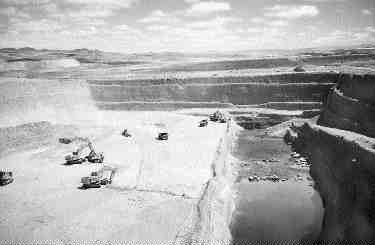South African-based
Trans Hex Group, which mines alluvial diamonds in South Africa and Namibia, formed THI in 1995 to function as its international exploration arm. It currently owns 73.2% of the junior’s 14.6 million shares outstanding and is its largest creditor.
Niel Hoogenhout, a director of each company, says the decision reflects cost-cutting as well as THI’s lack of progress. Nonetheless, THI has formed an independent committee, headed by directors Hugh Synder and Poul Hansen, to review its options.
“It’s really in their hands as to what can be negotiated,” says Hoogenhout, “but, from Trans Hex Group’s point of view, we cannot continue funding the exploration indefinitely.”
THI’s portfolio consists of: the 63%-owned Barra Grande project in Brazil; the half-owned Northbank project in Namibia; the 90%-owned Skeleton Coast project in Namibia; the 98%-owned Ngami project in Botswana; and the 15%-owned Limpopo project in Zimbabwe. Of these, Barra Grande and Northbank are the most advanced, though work at the latter has been stalled since 1998, owing to an ongoing legal dispute with a local landowner.
At Barra Grande, the company recently trenched 2,400 cubic metres of intermediate gravels from the Queixada area. Only 12 diamonds were recovered, just under half the number recovered from the Villa Barroso area.
The results prompted THI to write off $7.3 million in capitalized exploration expenditures in the 3-month period ended Sept. 30. The amount includes $2.3 million spent at Northbank and $27,000 at Limpopo. The Skeleton Coast and Ngami projects were left untouched, where a combined $656,000 has been spent.
Consequently, net losses for the quarter totalled $7.6 million, bringing the 6-month loss to $7.8 million. These figures compare with net losses of $328,000 and $556,000 in the respective periods of a year earlier.
At Sept. 30, Trans Hex had a working capital deficiency of $39,000, plus $4.5 million in long-term debt to related parties. Total liabilities outweighed total assets by some $3.2 million.
Meanwhile, Trans Hex Group and partner
The Namakwa airlift vessel, which can treat 50 tonnes of material per hour, began its first run in early November. It replaces the smaller Ivan Prinsep vessel, which has returned to Trans Hex’s South African concessions.
Trans Hex will deploy a second vessel to Marshall Fork in October 2002. Resources at Marshall Fork are pegged at 6.1 million cubic metres averaging 0.18 carat per cubic metre. That and another nearby feature are expected to yield 675,000 carats over seven years.


Be the first to comment on "Trans Hex cans international subsidiary"